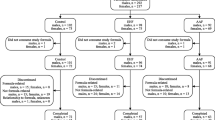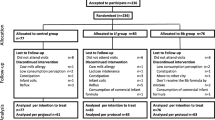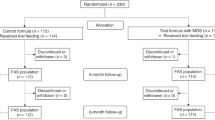Abstract
Objective
This study determined growth and stool characteristics of infants fed a formula with reduced content of a partially hydrolyzed protein of improved quality and assessed the effect of the addition of a probiotic on infant growth and health.
Design, methods
The double-blind study involved three formulas: a reduced protein (1.90 g/100 kcal) formula (formula RP), the same formula with Bifidobacterium lactis (formula RP+P), and a higher-protein (2.39 g/100 kcal) control formula (C). Protein of the formulas consisted of partially hydrolyzed modified whey proteins. Normal term infants were randomly assigned to one of the formulas, which were fed from soon after birth to 4 months of age; 88 infants completed the study. Growth was measured and formula tolerance, stool characteristics, and illness incidence were recorded.
Results
All three formulas supported growth equally well. Plasma concentrations of urea and of threonine and proline were markedly (significantly) lower with RP and RP+P than with C. No differences in feeding-related behaviors were noted, but stools were softer with formula C than with the other formulas. Infants fed RP+P had significantly fewer episodes of diarrhea (0.21 episodes) than infants fed RP (0.41 episodes) or C (0.91 episodes).
Conclusion
A reduced-protein formula with and without added probiotics (B. lactis) supports normal growth of infants during the first 4 months. In addition, it leads to lower plasma levels of urea, threonine, and proline. Supplementation of the formula with Bifidobacterium lactis offers protection against diarrheal illness.
Zusammenfassung
Ziel
Ziel der Untersuchung war nachzuweisen, dass eine Nahrung mit niedrigem Gehalt an hochwertigem hydrolysiertem Kuhmilcheiweiß bei gesunden Säuglingen normales Wachstum ermöglicht. Des Weiteren sollte untersucht werden, ob der Zusatz eines Probiotikums zu der Nahrung das Wachstum der Säuglinge bzw. den Gesundheitszustand beeinflusst.
Material und Methoden
Die Untersuchung wurde als prospektive, randomisierte Untersuchung im Doppelblindverfahren durchgeführt. Zwei Nahrungen mit reduziertem Eiweißgehalt (1,90 g/100 kcal) enthielten ein neuartiges Gemisch an teilhydrolysierten Molkenproteinen. Eine dieser Nahrungen (RP+P) enhielt zusätzlich Bifidobacterium lactis. Eine dritte Nahrung mit einem höheren Gehalt (2,39 g/100 kcal) an etwas anders zusammengesetzten Molkenproteinen diente als Kontrollnahrung (C). Gesunde, reifgeborene Säuglinge wurden per Zufallsreihe auf die 3 Nahrungen aufgeteilt, welche vom 8. Lebenstag bis zum Ende des 4. Lebensmonats verfüttert wurden. Gewicht und Länge wurden regelmäßig gemessen, und die Eltern registrierten Stuhleigenschaften, kindliches Verhalten sowie etwaige Erkrankungen des Kindes.
Ergebnisse
Die Säuglinge gediehen mit allen 3 Nahrungen gleich gut. Die Plasmaspiegel von Harnstoff, Threonin und Prolin waren signifikant niedriger bei den Säuglingen, welche die Nahrung RP bzw. RP+P erhielten, als bei den mit der Nahrung C ernährten Säuglingen. Letztere zeigten signifikant weichere Stühle als Säuglinge, die mit RP bzw. RP+P ernährt wurden. Im Verhalten der Säuglinge wurden keine Unterschiede festgestellt. Säuglinge, denen Nahrung RP+P verfüttert wurde, hatten signifikant seltener Durchfall (0,21 Episoden pro Kind) als diejenigen, welchen Nahrung RP (0,41 Episoden) bzw. Nahrung C (0,91 Episoden) verfüttert wurde.
Schlussfolgerung
Nahrung mit reduziertem Gehalt an hochwertigem Eiweiß führt bei Säuglingen in den ersten 4 Monaten zu normalem Gedeihen bei gleichzeitig niedrigeren Plasmaspiegeln von Harnstoff, Threonin und Prolin. Der Zusatz eines Probiotikums (Bifidobacterium lactis) schützt gegen Durchfallerkrankungen.
Similar content being viewed by others
References
Bachmann C, Haschke-Becher E (2002) Plasma amino acid concentrations in breast-fed and formula-fed infants and reference intervals. In: Räihä NCR, Rubaltelli FF (eds) Infant formula: closer to the reference. Lippincott Williams & Wilkins, Philadelphia, pp 121–137
Fomon SJ (1991) Requirements and recommended dietary intakes of protein during infancy. Pediatr Res 30:391–395
Fomon SJ, Nelson SE (1993) Size and growth. In: Fomon SJ (ed) Nutrition of normal infants. Mosby, St. Louis, pp 36–84
Fomon SJ, Ziegler EE (1999) Renal solute load and potential renal solute load in infancy. J Pediatr 134:11–14
Fomon SJ, Ziegler EE, Nelson SE, Rogers RR, Frantz JA (1999) Infant formula with protein-energy ratio of 1.7 g/100 kcal is adequate but may not be safe. J Pediatr Gastroenterol Nutr 28:495–501
Fomon SJ, Ziegler EE, Nelson SE, Frantz JA (1995) What is the safe protein-energy ratio for infant formulas? Am J Clin Nutr 62:358–363
Fawcett JK, Scott JE (1960) A rapid and precise method for the determination of urea. J Clin Pathol 13:156–159
Ghisolfi J, Roberfroid M, Rigo J, Moro G, Polanco I (2002) Infant formula supplemented with probiotics or prebiotics: never, now, or someday? J Pediatr Gastroenterol Nutr 35:467–468
Guandalini S, Gupta P (2002) The role of probiotics in gastrointestinal disorders of infancy and childhood. In: Räihä NCR, Rubaltelli FF (eds) Infant formula: closer to the reference. Lippincott Williams & Wilkins, Philadelphia, pp 29–43
Lehane DP, Levy AL, Ergis AS (1978) Colorimetric quantification of albumin in microliter volumes of serum. Ann Clin Lab Sci 8:122–126
Marteau PR, de Verse M, Cellier CJ, Schrezenmeir J (2001) Protection from gastrointestinal diseases with use of probiotics. Am J Clin Nutr 73:430S-436S
Metges CC (2001) Does dietary protein in early life affect the development of adiposity in mammals? J Nutr 131:2062–2066
Nelson, SE, Rogers, RR, Ziegler, EE, Fomon, SJ (1989) Gain in weight and length during early infancy. Early Hum. Dev. 19:223–239
Räihä NCR, Fazzolari Nesci A, Cajozzo C, Puccio G, Monestier A, Moro GE, Minoli, Haschke-Becher E, Bachmann C, Van't Hof M, Carrié-Fässler A-L, Haschke F (2002) Whey predominant, whey modified infant formula with protein/energy ratio of 1.8 g/100 kcal is adequate and safe for term infants from birth to four months. J Pediatr Gastroenterol Nutr 35:275–281
Saavedra JM (2002) Probiotic agents: clinical applications in infants and children. In: Räihä NCR, Rubaltelli FF (eds) Infant formula: closer to the reference. Lippincott Williams & Wilkins, Philadelphia, pp 15–24
Saavedra JM, Bauman NA, Oung I, Perman JA, Yolken RH (1994) Feeding of Bifidobacterium bifidum and Streptococcus thermophilus to infants in hospital for prevention of diarrhoea and shedding of rotavirus. Lancet 344:1046–1049
Ziegler EE (2002) Protein requirements in infancy. In: Räihä NCR, Rubaltelli FF (eds) Infant formula: closer to the reference. Lippincott Williams & Wilkins, Philadelphia, pp 97–110
Author information
Authors and Affiliations
Corresponding author
Rights and permissions
About this article
Cite this article
Ziegler, E.E., Jeter, J.M., Drulis, J.M. et al. Formula with reduced content of improved, partially hydrolyzed protein and probiotics: infant growth and health. Monatsschr Kinderheilkd 151 (Suppl 1), S65–S71 (2003). https://doi.org/10.1007/s00112-003-0804-0
Published:
Issue Date:
DOI: https://doi.org/10.1007/s00112-003-0804-0




